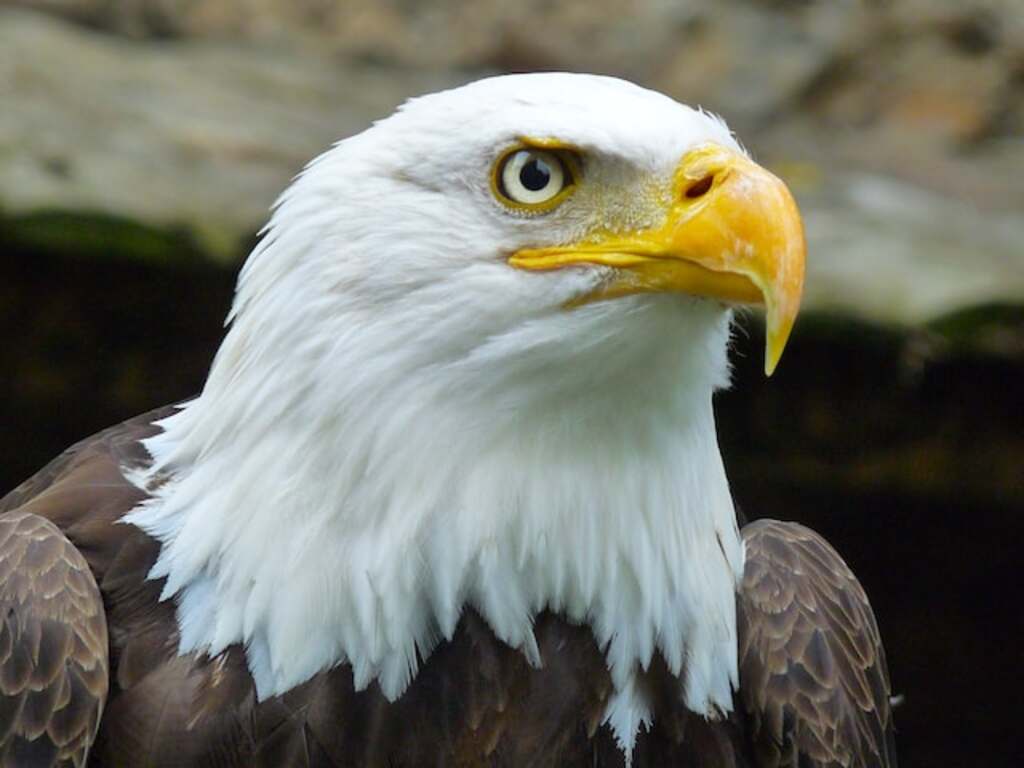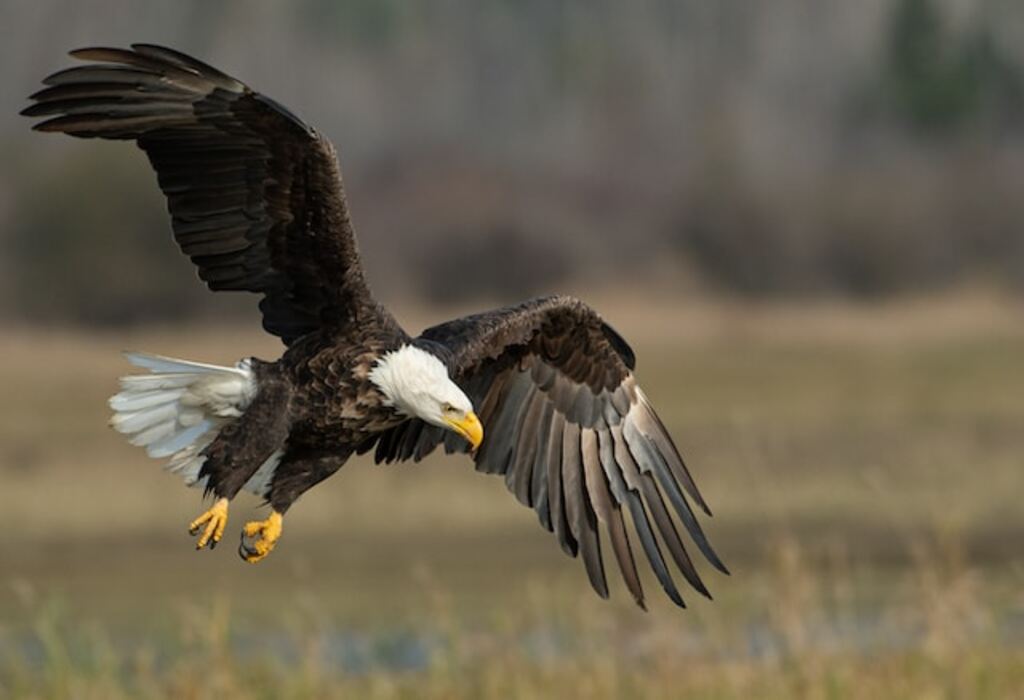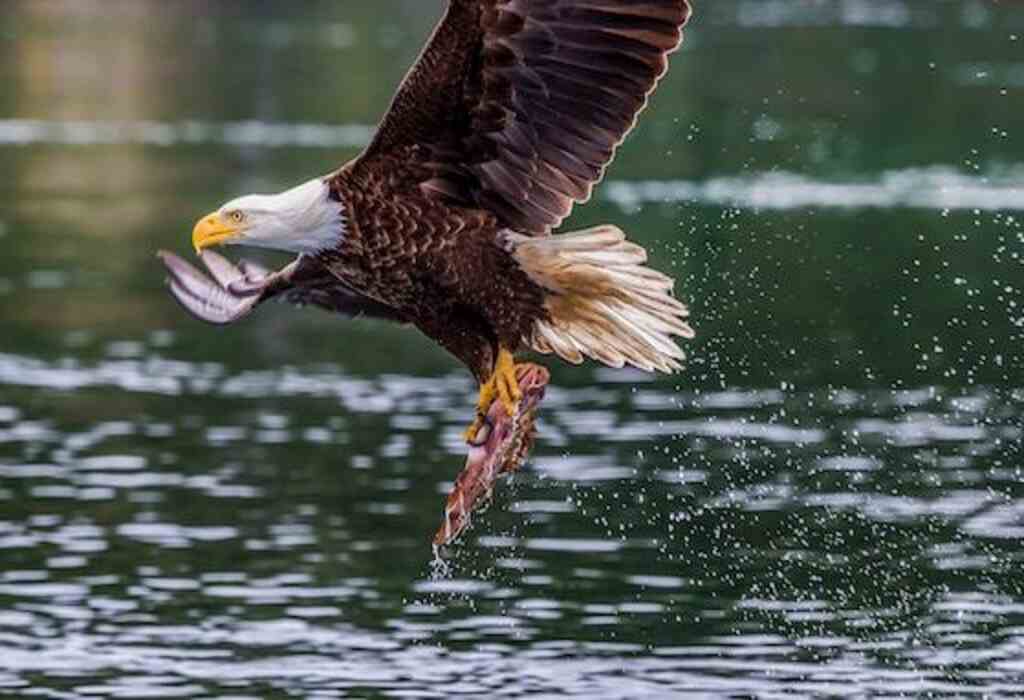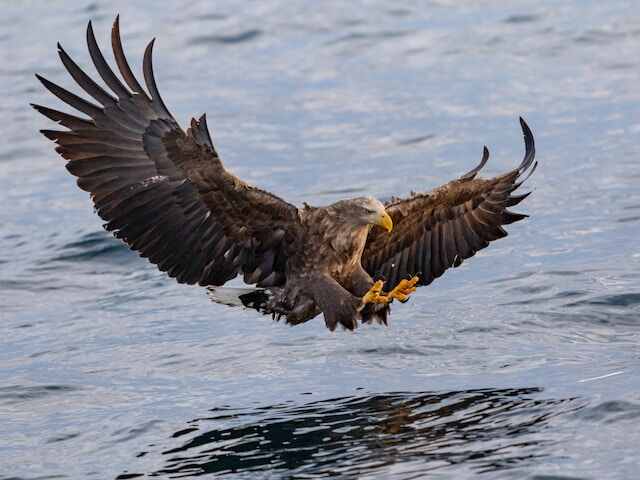How Do Eagles’ Eyes Work? Prepare for a bird’s-eye view into the extraordinary world of eagle vision! Ever wondered how these majestic creatures perceive the world around them with such precision?
Brace yourself for the short answer, fascinating insights into their exceptional visual abilities, and a captivating exploration of the marvels behind those piercing eagle eyes.
Get ready to see the world through new feathers!
Table of Contents
- 1 Key Takeaways
- 2 How Do Eagles Eyes Work
- 3 An Overview of Eagle Eyesight
- 4 Anatomy of an Eagle Eye
- 5 Visual Acuity
- 6 Field of Vision
- 7 Adaptations for Flight
- 8 Hunting Strategies
- 9 Comparison to Other Birds
- 10 Human Applications
- 11 Conservation Efforts
- 12 Frequently Asked Questions
- 12.1 How do eagles’ eyes compare to the eyes of other animals besides birds?
- 12.2 Do eagles have any unique adaptations in their eyes that are not related to their hunting or flight capabilities?
- 12.3 Can eagles’ eyesight be affected by environmental factors such as pollution or climate change?
- 12.4 How do eagles’ eyes develop and change over their lifespan?
- 12.5 Are there any cultural or historical references to eagles and their eyesight in human societies?
- 13 Conclusion
- 14 Author
Key Takeaways
- Eagle eyes have remarkable visual acuity and unique characteristics, including a large cornea and high density of photoreceptor cells, allowing for a panoramic view and binocular vision with depth perception.
- Eagles use a range of adaptations and behaviors, including keen eyesight, to efficiently catch prey, such as spotting prey from a distance, adjusting position and angles of view to compensate for wind, and diving from great heights to snatch the target in mid-air.
- Other raptors, including falcons, owls, ospreys, and kestrels, also have exceptional visual abilities, a wider field of vision than humans, and eyesight eight times more powerful than humans, with the ability to detect and avoid collision with small objects and see ultraviolet light.
- Conservation efforts to protect eagle habitats and prey are crucial for survival and ecosystem preservation, involving community involvement and policy implementation, as well as technology to track eagle populations and behaviors for management decisions.

How Do Eagles Eyes Work
Eagles’ eyes work marvelously, granting them exceptional vision for hunting and navigation.
Their large, sharp eyes, packed with specialized cells called cones, provide acute color vision and the ability to see fine details from afar.
Their unique double fovea allows them to focus on both distant prey and objects up close simultaneously.
An Overview of Eagle Eyesight
The eagle’s eyesight is a remarkable adaptation that allows them to hunt effectively in both daylight and low-light conditions, with a visual acuity that is several times greater than humans.
Eagle eye evolution has allowed them to develop a unique set of characteristics, including large eyes relative to their head size, a high density of photoreceptor cells, and a greater concentration of cone cells in the fovea, which is responsible for high-resolution vision.
Additionally, the cultural significance of eagle eyesight has been widely recognized throughout history, with many cultures associating eagles with strength, freedom, and power.
The anatomy of an eagle eye is equally impressive, with features such as a bony ring that surrounds the eye, allowing for greater control and stabilization of the eye, and a large cornea that helps to focus light onto the retina.
Understanding the intricacies of an eagle’s eyesight provides insight into their impressive hunting abilities and the unique adaptations that have allowed them to thrive in their natural environment.
Anatomy of an Eagle Eye
An intricate network of photoreceptor cells, including cones and rods, are present in the retina of an eagle’s eye, allowing for exceptional visual acuity and color perception.
The eagle’s eye anatomy is specifically designed to enable it to hunt even the smallest prey from a great height.
Eagle eye development begins at an early stage when the eye structure and function are optimized to suit their predatory lifestyle.
The eagle’s eye vision range is around 340 degrees, which is significantly wider than humans. This allows eagles to have a panoramic view of their surroundings, including their prey.
Additionally, eagles have a high density of photoreceptor cells, allowing them to see much more clearly than humans.
Eagles also have a much higher number of color-detecting cone cells, enabling them to see colors that are invisible to humans.
With such a specialized eye structure, eagles can track their prey with precision, even from great distances.
As we move into the next section about visual acuity, it is important to note that the eagle’s eye structure is a primary factor in their exceptional hunting abilities.
Visual Acuity
Visual acuity is a measure of the ability of an eye to distinguish between two points that are close together.
For eagles, visual acuity is an essential aspect of their hunting ability, as it allows them to spot prey from far distances and track their movements accurately.
The importance of visual acuity in eagles is reflected in their eye structure, which contains a high density of cone cells in the fovea, the area responsible for sharp central vision.
To measure visual acuity in eagles, researchers use a variety of techniques, including behavioral tests and electrophysiological recording.
These methods provide insight into the eagle’s impressive visual capabilities, which can exceed human visual acuity in certain situations.
Overall, understanding the measurement and importance of visual acuity in eagles is crucial for appreciating the unique abilities of these magnificent birds of prey.
Moving on to the next section, the field of vision is another crucial aspect of eagle vision that contributes to their hunting success.

Field of Vision
One can envision the panoramic view that eagles possess by imagining a wide-angle camera lens that captures a wide expanse of the surrounding environment.
Eagles have a remarkable field of vision that allows them to see prey from great distances.
Their eyes are positioned on the front of their heads, providing binocular vision and depth perception that is crucial for hunting.
Additionally, eagles have a wider field of view than humans, with a horizontal range of 340 degrees.
This allows them to scan the environment for potential threats or prey without turning their heads.
Eagles’ eyes are also equipped with a high density of photoreceptors, which enhances their visual acuity and sensitivity to light.
Their peripheral vision is also exceptional, allowing them to detect movement from a distance and spot potential predators.
Overall, eagles have a highly specialized visual system that is essential for survival and hunting.
This adaptation for survival will be discussed further in the subsequent section about adaptations for flight.
Adaptations for Flight
Adaptations for flight in birds are numerous and complex, and three key adaptations are binocular vision, eye movements, and stabilization.
Binocular vision allows for depth perception, which is crucial for accurate flight and hunting.
Eye movements are essential for keeping a bird’s eyes on a target while in flight, and stabilization mechanisms help birds maintain balance and stability in the air.
These adaptations are crucial for the success of birds in their aerial habitat.
Binocular Vision
The ability of eagles to focus both eyes on the same object, known as binocular vision, allows them to accurately judge distances and accurately capture prey.
This type of vision provides the bird with depth perception, which is critical for hunting success.
Eagles have a narrow field of view compared to humans, but their binocular vision allows for sensory fusion, which combines the images from each eye into a single, three-dimensional image.
This gives the eagle a more accurate representation of the world around them, making it easier to locate and capture prey.
Eye movements also play a critical role in eagle vision, allowing the bird to track prey while in flight.
With the ability to rapidly adjust their eye movements, eagles can maintain focus on their target, even at high speeds.
This combination of binocular vision and precise eye movements makes eagles some of the most effective hunters in the animal kingdom.
Eye Movements
Binocular vision plays a crucial role in an eagle’s visual perception, but it is not the only factor that contributes to their exceptional eyesight.
Eye movements, including saccades and smooth pursuit, allow eagles to track moving objects with remarkable accuracy.
Their eye tracking abilities are so precise that they can fixate on a single point while flying at high speeds, ensuring that their target remains in the center of their visual field.
This enables eagles to not only spot prey from a great distance, but also to pursue and capture it with ease.
By understanding how eagles use their eye movements to enhance their visual perception, we can gain valuable insight into the mechanisms that underlie their extraordinary vision.
Moving forward, we will explore how eagles use stabilization to maintain a clear view of their surroundings.
Stabilization
Stabilization is an essential mechanism that eagles use to maintain a clear and steady view of their surroundings.
To achieve this, eagles employ various stabilization techniques, including their strong neck muscles, which allow them to keep their heads steady even in the face of strong winds.
Additionally, eagles have a specialized structure called the fovea, which helps them to focus on specific objects and maintain a clear view of their surroundings.
The fovea is densely packed with light receptors called cones, which provide the eagle with sharp vision and color perception.
However, the impact of wind on eagle eyesight cannot be ignored, as it can cause the eagle’s vision to become blurred or distorted.
To overcome this challenge, eagles use their keen eyesight and extensive hunting experience to adjust their position and angles of view to compensate for the wind.
These techniques allow eagles to stabilize their vision and maintain a clear view of their surroundings, enabling them to accurately spot their prey and execute their hunting strategies.

Hunting Strategies
The hunting strategies of eagles are a fascinating topic of study, as they involve a range of adaptations and behaviors that allow these birds of prey to catch their prey efficiently.
One of the key strategies is the ability to spot prey from a distance using their keen eyesight, which allows them to identify potential targets even from high altitudes.
Once a suitable prey is identified, eagles use their impressive diving skills to catch their prey, often reaching speeds of up to 150 miles per hour.
Additionally, eagles must navigate their way through the environment while in flight, avoiding obstacles such as trees and buildings, which requires a high level of precision and spatial awareness.
Spotting Prey from a Distance
With their remarkable visual acuity, eagles can spot prey from distances that would seem impossible to humans, making them one of the most efficient hunters in the animal kingdom.
This ability is due to their unique eye structure and the way their eyes work.
Eagles have two foveae, a small depression in the retina responsible for sharp, detailed vision, which enables them to see both forward and to the side simultaneously.
They also have a much higher concentration of rods and cones, the cells responsible for detecting light and color, than humans, giving them the ability to see in greater detail and distinguish between subtle differences in color.
Additionally, eagles can adjust the shape of their lenses to focus on objects both near and far, allowing them to maintain clarity at great distances.
Prey behavior and environmental factors also play a role in the eagle’s ability to spot prey. For example, eagles are more likely to spot prey when it is moving, as the motion catches their attention.
They also have a better chance of spotting prey in open areas with little vegetation or cover, as this allows for a clearer line of sight.
Overall, the eagle’s keen eyesight helps them to locate prey from a distance, making them an efficient hunter.
This ability is just one aspect of their hunting strategy, which also includes diving and catching prey in mid-air.
Diving and Catching Prey
To catch their prey, eagles use a hunting strategy that involves diving from great heights and snatching their target in mid-air.
This technique requires both speed and accuracy, as the eagle must reach a velocity of up to 120 mph to catch its prey.
Additionally, the eagle must be able to adjust its flight path in real time, using its keen eyesight to track the movements of its prey and make split-second decisions about how best to catch it.
As the eagle closes in on its target, it spreads its wings to slow its descent and opens its talons to grasp its prey.
This hunting technique is both breathtaking and efficient, allowing eagles to capture prey that would be otherwise impossible to catch.
In the next section, we will explore how eagles avoid obstacles in flight.
Avoiding Obstacles in Flight
Navigating through their environment, eagles must be able to avoid obstacles in flight.
Obstacle detection and spatial awareness are essential skills for eagles, as they must be able to fly at high speeds and maneuver through complex environments without colliding with objects.
Studies have shown that eagles can detect and avoid collision with objects as small as 2.5 cm in diameter, thanks to their sharp vision and ability to process visual information quickly.
As they fly through their surroundings, eagles are able to identify potential obstacles and adjust their flight path accordingly, allowing them to avoid collisions and maintain their freedom in the open skies.
These skills are particularly important for eagles that hunt in densely forested or mountainous areas, where obstacles are abundant.
In the next section, we will compare the obstacle detection and spatial awareness abilities of eagles with those of other birds.

Comparison to Other Birds
The sharp vision of raptors is not unique among birds. Many other birds possess remarkable visual capabilities that allow them to hunt, navigate, and communicate effectively.
Some examples of birds with sharp vision include owls, hawks, falcons, and eagles.
In this subtopic, we will compare the vision of eagles to that of other birds, exploring similarities and differences in their visual systems and hunting strategies.
Raptors
Raptors, which include eagles, have exceptional visual acuity that enables them to spot prey from a distance of up to 2 miles away. Their hunting techniques and sharp vision make them the ultimate predators of the sky.
Here are some fascinating facts about raptors that will evoke emotion in the audience:
- They have a field of vision of 340 degrees, which is much wider than that of humans.
- Their eyesight is eight times more powerful than humans, allowing them to see even the smallest of prey from afar.
- They are capable of seeing ultraviolet light, which helps them detect the urine trails of potential prey that are invisible to the naked human eye.
- They have a second fovea, a small pit in the retina, which enables them to focus on objects with exceptional clarity.
- They can adjust the curvature of their lens, changing their focus from distant to close objects within seconds.
These incredible abilities make raptors, including eagles, highly efficient hunters, and a symbol of freedom and power.
Other birds with sharp vision, such as falcons and owls, also possess unique vision adaptations that allow them to thrive in their respective habitats.
Other Birds with Sharp Vision
Falconiformes, the order of birds that includes falcons and hawks, possess exceptional vision adaptations that allow them to hunt with incredible precision. However, it is not just these birds that have sharp vision.
Owls, for example, have eyes that are adapted to low-light conditions, allowing them to hunt in the dark. Their large eyes are also capable of detecting motion from far away.
Similarly, falcons have an acute sense of vision, which allows them to spot prey from great distances.
They have a unique fovea, a small depression in the retina that is densely packed with photoreceptor cells, allowing them to see with greater clarity.
Other birds with sharp vision include eagles, ospreys and kestrels.
The ability of these birds to see with such precision has inspired scientists to study their visual systems and to apply this knowledge to various human applications.
Human Applications
One potential application of the unique visual abilities of eagles could be in the development of advanced imaging technology for medical and scientific purposes.
The ability of eagles to see far and with great detail could be harnessed to create imaging technology that can capture images with greater clarity and detail than current technology.
This could have a significant impact on medical imaging, such as MRI and CT scans, and scientific imaging, such as in telescopes and microscopes.
The innovations that could come from studying the visual system of eagles could lead to breakthroughs in imaging technology that could change the way we see the world around us.
The conservation efforts to protect eagles and their habitats are crucial in ensuring that we continue to learn from and benefit from these magnificent creatures.

Conservation Efforts
Efforts to conserve the habitats of these majestic birds are of utmost importance as their disappearance would be an irreplaceable loss to our ecosystem and the natural world as a whole, highlighting the need for urgent action.
Conservation efforts require community involvement and policy implementation to ensure the preservation of eagle habitats and their prey.
One effective strategy is the establishment of protected areas where human activities are limited.
Another is to work with local communities to promote sustainable land use practices that reduce habitat destruction.
Additionally, conservationists are using technology to track eagle populations and monitor their behaviors, which can inform management decisions.
It is crucial to continue these efforts to protect the eagle’s natural environment and ensure their survival for future generations.
Frequently Asked Questions
How do eagles’ eyes compare to the eyes of other animals besides birds?
Compared to other predators, eagles have unique eye structures that allow them to see long distances, detect UV light, and have high color contrast. Eagles’ keen vision has inspired art and mythology throughout history, symbolizing freedom and strength.
Eagles have unique adaptations in their eyes, such as a fast pupillary response and high-density cones for color vision. These adaptations aid in hunting and flight but also make eagles sensitive to light and color, enhancing their overall visual experience.
Can eagles’ eyesight be affected by environmental factors such as pollution or climate change?
The impact of pollutants on eagles’ eyesight and effects of climate change on eagle vision are topics of concern. Research suggests that environmental factors can affect eagle vision, but more studies are needed to fully understand the extent of their impact.
How do eagles’ eyes develop and change over their lifespan?
Avian vision research shows that eagles’ eye development changes throughout their lifespan. Comparisons with other predator eyesight reveal adaptations for long-distance and acute vision, color perception, and sensitivity to UV light.
Are there any cultural or historical references to eagles and their eyesight in human societies?
Despite the lack of scientific evidence, eagles’ eyesight has been mythologized in various cultures throughout history. Eagles are often associated with strength and vision, and their eyesight is revered as a symbol of supernatural power.

Conclusion
The eagle has been revered for centuries for its keen eyesight, which allows it to spot prey from great distances.
The anatomy of an eagle’s eye is fascinating, with adaptations that enhance visual acuity and field of vision.
These adaptations are crucial for flight and hunting, as eagles can spot prey from high altitudes and swoop down at great speeds to catch it.
Compared to other birds, eagles have superior visual acuity, with the ability to see up to eight times farther than humans.
Their eyes are also able to adjust to changes in light quickly, allowing them to see in both bright sunlight and low light conditions.
Furthermore, the positioning of their eyes on the front of their heads provides them with binocular vision, allowing them to judge distances accurately.
Despite their impressive abilities, eagles remain threatened due to habitat loss, poaching, and other human activities.
As humans, we have much to learn from these magnificent creatures, particularly in the field of optics.
By studying the adaptations of eagle eyesight, we can develop new technologies that can aid in various fields, such as aviation, medicine, and engineering.
It is ironic that the very creatures we admire for their visual abilities are at risk due to human actions.
By taking action to preserve their habitats and protect them from harm, we can ensure that the eagle’s magnificent eyesight continues to inspire us for generations to come.



